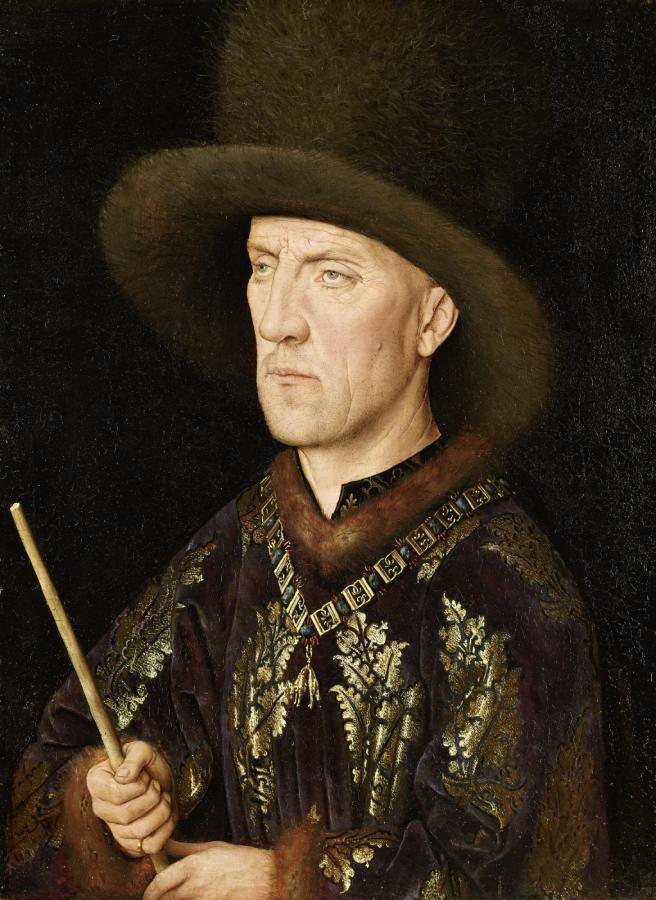Van Eyck, Jan (c.1390-1441)
Portrait of Baudouin de Lannoy
c.1435
Oil on oak, 26.6 x 19.5 cm
Gemäldegalerie, Berlin
The middle-aged, male subject of this portrait is depicted as a half-figure who turns towards the left and is presented in front of a dark, atmospheric, yet indeterminate background. His gaze is directed towards the side and into the distance, somewhere outside of the picture space. There can be little doubt that this image is designed to signal remoteness and dignity, just as the compressed lips are meant as an expression of decisiveness and resolve. The precious gold brocade robe and the enormous fur hat are insignia indicating an extremely high social rank. The gold chain he wears confirms this: the collar indicates membership in the Order of the Golden Fleece, the most elite knightly order in the Western world, established in 1430 by the Burgundian Duke Philip the Good, and reserved for the highest nobility – initially, membership was restricted to 30 individuals. Through an inscription on a drawn copy of this portrait panel dating from the 16th century (which is found in the so-called “Recueil d’Arras” manuscript), we know the identity of this distinguished gentleman. He is Baudouin de Lannoy (1388–1474), Lord of Molembais, who was called “the stutterer”. He was accepted as a Knight of the Golden Fleece when the order was first founded. He was Governor of Lille beginning in 1423, and a counsellor and chamberlain to Duke Philip beginning in the early 1430s. In the present picture, the simple staff in pale wood held by the sitter alludes to the rank of chamberlain, a courtly office that was restricted to the high nobility and designed to confer honour rather than entailing the fulfilment of specific duties. During the years 1428–29, Baudouin de Lannoy accompanied a delegation to Portugal, entrusted with the mission of courting the Infantin, later Queen Isabella, on behalf of the Duke. Philip’s court painter Jan van Eyck took part in this journey as well, during which he executed a – today lost – portrait of the princess in order to provide the Duke with an impression of his prospective bride.
Lannoy therefore knew Jan van Eyck personally, and must have been familiar with his portraiture at the latest during this journey. Based on stylistic features, the present portrait must have been executed considerably later. A date of the late 1430s would also be consistent with the sitter’s outward appearance – Lannoy turned 50 in 1438. Like all of the portraits from Jan van Eyck‘s hand, the present likeness is captivating by virtue of its meticulously elaborated rendering of the features of an individual’s face. Areas of irregularity and discolouration on the skin, along with unattractive features such as the thick nasal bridge of Lannoy‘s nose, are apprehended in a bright, frontal illumination. Admittedly, it is no longer possible to determine the degree to which the sitter was idealised or the aristocratic aspect of his appearance heightened. But, there is little doubt that Lannoy – whose prideful
character is reported by chroniclers – wished to appear aristocratic. The memorable quality of his head and the sitter’s almost morose expression along with, and the enormous hat, other help to account for the fact that almost 200 years later, Peter Paul Rubens drew a copy of this portrait in one of his sketchbooks. (Gemäldegalerie)
See also:
• Lannoy, Baudouin de (1388-1474)
